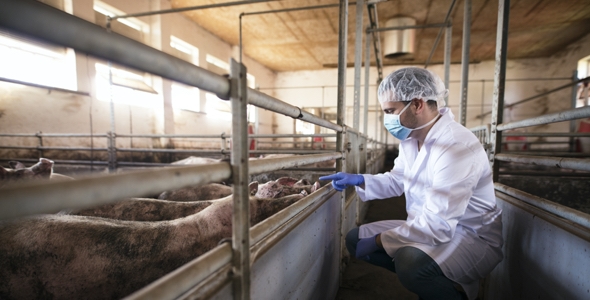Can Viruses Be Transmitted From Animals to Humans?

This article examines the potential transmission of viruses from animals to humans. Zoonotic viruses, which are capable of crossing species barriers, pose a significant public health concern. Understanding the mechanisms and factors that facilitate animal-to-human transmission is crucial for effective prevention and control.
Notable examples of zoonotic viruses, such as Ebola and COVID-19, highlight the serious implications of such transmissions. Additionally, the role of wildlife in the spread of zoonotic diseases is explored.
By examining current concerns and future preparedness, this article aims to contribute to our understanding of animal-to-human virus transmission and inform strategies for prevention.
Key Takeaways
- Zoonotic viruses can be transmitted from animals to humans through direct contact, consumption of contaminated animal products, or exposure to environmental sources.
- Understanding zoonotic transmission is crucial for effective disease surveillance and prevention.
- Factors influencing cross-species transmission include genetic reassortment, receptor binding specificity, immune evasion, and environmental factors.
- Comprehensive prevention and control measures, including surveillance, early detection, and collaboration between sectors, are essential to disrupt the transmission cycle and prevent zoonotic transmission.
Zoonotic Viruses: What Are They?
Zoonotic viruses are infectious agents that can be transmitted from animals to humans. Understanding zoonotic transmission is crucial for effective zoonotic disease surveillance and prevention. Zoonotic diseases pose a significant threat to global public health, as they can cause outbreaks and pandemics.
The transmission of zoonotic viruses can occur through various routes, including direct contact with infected animals, consumption of contaminated animal products, or exposure to environmental sources contaminated with viral particles. Zoonotic disease surveillance plays a vital role in identifying and monitoring potential outbreaks, allowing for early detection and rapid response measures.
Surveillance efforts involve the collection and analysis of data on animal and human health, as well as the sharing of information between different sectors and countries. By enhancing our understanding of zoonotic transmission and implementing effective surveillance strategies, we can better prevent and control the spread of zoonotic viruses.
Understanding Animal-to-Human Transmission
This discussion aims to explore the cross-species transmission mechanisms of zoonotic infections and the strategies for preventing such infections.
Understanding how pathogens are transmitted from animals to humans is crucial in developing effective prevention and control measures. By analyzing the various transmission routes and mechanisms, we can gain insights into the factors contributing to zoonotic outbreaks and identify potential interventions to reduce the risk of zoonotic infections.
Cross-Species Transmission Mechanisms
Cross-species transmission mechanisms of viruses involve the transfer of viral pathogens from animals to humans. This phenomenon poses significant cross species transmission risks, as it can lead to the emergence of novel infectious diseases in humans. Evolutionary adaptations play a crucial role in enabling viruses to jump from one species to another.
Here are four key mechanisms involved in cross-species transmission:
- Genetic reassortment: Viruses with segmented genomes can exchange genetic material with other viruses during co-infection, creating new virus strains capable of infecting different hosts.
- Receptor binding specificity: Viruses can evolve to recognize and bind to receptors present in multiple species, facilitating their entry into new hosts.
- Immune evasion: Viruses can adapt to evade or suppress the immune response of the host, allowing them to establish infection in a new species.
- Environmental factors: Changes in the environment, such as deforestation or urbanization, can increase contact between humans and animals, promoting the transmission of animal viruses to humans.
Understanding these cross-species transmission mechanisms is vital for predicting and preventing future outbreaks of zoonotic diseases.
Preventing Zoonotic Infections
Preventing zoonotic infections requires a comprehensive approach that focuses on understanding and addressing the factors contributing to the transmission of pathogens between different species.
Effective zoonotic transmission prevention strategies involve various measures, including surveillance, early detection, and control of diseases in both animal and human populations.
Surveillance systems play a crucial role in monitoring the emergence and spread of zoonotic pathogens, enabling timely interventions.
Early detection of zoonotic infections in animals is essential to prevent their transmission to humans. This can be achieved through regular monitoring of animal health, vaccination programs, and implementing biosecurity measures.
Control measures should include promoting good hygiene practices, such as handwashing, proper waste management, and safe handling and preparation of animal products.
Collaboration between human and animal health sectors, along with interdisciplinary research and education, are necessary for effective prevention and control of zoonotic infections.
Notable Examples of Zoonotic Viruses
One of the notable examples of zoonotic viruses is the Ebola virus, which was first identified in humans in 1976 after an outbreak in Sudan and Zaire. This virus is considered a significant zoonotic pathogen due to its ability to cause severe illness and high mortality rates in humans.
Ebola is primarily transmitted to humans through close contact with infected animals, such as fruit bats, and then spreads from person to person through direct contact with blood or other bodily fluids.
The global impact of zoonotic viruses like Ebola is profound, as they can lead to large-scale outbreaks with devastating consequences for public health and socioeconomic stability.
Understanding the transmission dynamics and implementing effective control measures is crucial in preventing and mitigating the impact of these notable zoonotic outbreaks.
Factors Influencing Cross-Species Transmission
Factors influencing the transmission of zoonotic pathogens between different species have been the focus of extensive research in order to understand the mechanisms by which these pathogens can cross species barriers and potentially lead to outbreaks in human populations.
Various factors have been identified that can influence the transmission of zoonotic viruses from animals to humans. These factors include:
- Genetic compatibility: The genetic makeup of both the virus and the host species can play a crucial role in determining whether the virus can successfully infect and replicate in the new host.
- Environmental factors: The environment in which the transmission occurs, such as the presence of suitable vectors or reservoirs, can greatly influence the likelihood of cross-species transmission.
- Human behavior: Human activities, such as encroachment into wildlife habitats or the consumption of bushmeat, can increase the chances of contact with zoonotic viruses.
- Viral adaptation: Viruses can undergo genetic mutations or recombination events that enhance their ability to infect new hosts, facilitating cross-species transmission.
Understanding these factors and their influences is essential for the development of effective strategies to prevent and control zoonotic outbreaks.
The Role of Wildlife in Zoonotic Disease Spread
The previous subtopic discussed the various factors that influence cross-species transmission of viruses. Now, we will focus on the role of wildlife in zoonotic disease spread. Wildlife, which encompasses a wide range of animals including mammals, birds, reptiles, and insects, can serve as reservoirs and vectors for numerous viruses. This poses significant implications for global health, as zoonotic diseases can have devastating consequences. To highlight the importance of wildlife conservation in mitigating these risks, a table is provided below showcasing some notable zoonotic diseases and their associated wildlife hosts.
| Zoonotic Disease | Wildlife Host | Global Health Implications |
|---|---|---|
| Ebola | Fruit bats, primates | Severe hemorrhagic fever |
| Avian Influenza | Birds | Potential pandemic threat |
| Lyme Disease | Rodents, deer | Chronic illness |
| Zika Virus | Mosquitoes, primates | Birth defects |
This table serves as a reminder of the interconnectedness between wildlife, zoonotic diseases, and global health. It emphasizes the urgent need for effective wildlife conservation strategies to safeguard both animal populations and human well-being.
Preventing Animal-to-Human Virus Transmission
Zoonotic transmission prevention, animal vaccination strategies, and the importance of hygiene practices are crucial aspects to consider when addressing the issue of animal-to-human virus transmission.
Effective prevention measures aim to disrupt the transmission cycle and reduce the risk of zoonotic diseases spreading to humans.
Animal vaccination strategies play a significant role in controlling the spread of zoonotic diseases by reducing the prevalence of pathogens in animal populations.
Additionally, maintaining good hygiene practices, such as proper handwashing and sanitation, can further minimize the risk of zoonotic transmission and promote public health.
Zoonotic Transmission Prevention
Preventing zoonotic transmission requires implementing effective strategies and interventions. Zoonotic transmission control is crucial in minimizing the risk of viral transmission from animals to humans.
Public health measures play a significant role in preventing and controlling zoonotic diseases. These measures include surveillance and monitoring of animal populations, early detection and reporting of potential zoonotic outbreaks, and appropriate response strategies.
Public health agencies collaborate with veterinary services to identify high-risk areas and implement targeted interventions, such as vaccination campaigns, animal control measures, and health education programs.
Additionally, promoting good hygiene practices, such as regular handwashing, proper food handling, and safe livestock management, can also contribute to the prevention of zoonotic transmission.
Effective zoonotic transmission control requires a multidisciplinary approach involving collaboration between human and animal health sectors, as well as continuous research and surveillance to identify emerging zoonotic threats.
Animal Vaccination Strategies
Zoonotic transmission prevention plays a crucial role in reducing the risk of viruses being transmitted from animals to humans. One effective strategy in this regard is the implementation of animal vaccination programs. By vaccinating animals against zoonotic diseases, such as rabies or avian influenza, the likelihood of transmission to humans can be significantly reduced.
Animal vaccination strategies involve identifying the specific diseases that pose a zoonotic risk and developing vaccines that are safe and effective in preventing their transmission. These strategies often involve collaboration between veterinary and public health professionals to ensure comprehensive coverage and monitoring.
Additionally, regular vaccination campaigns and proper record-keeping are essential to maintain the effectiveness of animal vaccination programs and prevent outbreaks of zoonotic diseases.
Importance of Hygiene Practices
The implementation of proper hygiene practices is of utmost importance in reducing the risk of disease transmission from animals to humans. Handwashing techniques and the use of Personal Protective Equipment (PPE) are crucial in preventing the spread of pathogens. Handwashing should be performed with soap and water for at least 20 seconds, ensuring that all surfaces of the hands are thoroughly cleaned. PPE, such as gloves, masks, and gowns, should be used when handling animals or their bodily fluids to minimize direct contact. This helps to prevent the transfer of pathogens from animals to humans. The table below presents a comparison of recommended handwashing techniques and the types of PPE that should be used in different animal handling situations.
| Handwashing Techniques | Personal Protective Equipment (PPE) |
|---|---|
| Use soap and water | Gloves |
| Scrub hands for 20 seconds | Masks |
| Clean all surfaces | Gowns |
| Rinse thoroughly |
Emerging Zoonotic Viruses: Current Concerns and Future Preparedness
Emerging zoonotic viruses pose significant challenges for public health authorities in terms of timely detection and effective response strategies. The current challenges faced by public health authorities include:
- The rapid spread of these viruses
- The difficulty in identifying their source
- The lack of specific treatment options
Additionally, the globalization of trade and travel has increased the risk of these viruses spreading across borders, further complicating the response efforts.
To address these challenges, future strategies should focus on:
- Strengthening surveillance systems for early detection
- Improving communication and collaboration between different sectors and countries
- Investing in research and development of vaccines and antiviral drugs
It is also crucial to enhance public awareness and education regarding zoonotic viruses to promote preventive measures and reduce the risk of transmission.
Frequently Asked Questions
What Are Some Ways to Prevent Animal-To-Human Transmission of Viruses?
Prevention methods are crucial in reducing the risk of animal-to-human transmission of viruses. Public awareness campaigns, strict biosecurity measures in animal farms, and proper handling and cooking of animal products are effective strategies in preventing such transmission.
What Are the Factors That Influence the Transmission of Viruses From Animals to Humans?
Factors influencing the transmission of viruses from animals to humans include close contact with infected animals, consumption of contaminated animal products, exposure to bodily fluids, and environmental factors that facilitate pathogen survival and transmission.
Can Viruses Be Transmitted From Humans to Animals as Well?
Viruses can be transmitted from humans to animals through various mechanisms, such as direct contact, respiratory droplets, or contaminated surfaces. Prevention strategies, including quarantine measures and proper hygiene practices, should be implemented to minimize cross-species transmission.
Are There Any Zoonotic Viruses That Are Currently Causing Major Concerns?
Zoonotic virus outbreaks pose significant global health concerns. These viruses are capable of crossing species barriers and infecting both animals and humans, leading to potential pandemics and necessitating rigorous surveillance and control measures.
What Measures Are Being Taken to Prepare for Future Zoonotic Virus Outbreaks?
Preventive measures and surveillance systems are being implemented to prepare for future zoonotic virus outbreaks. These measures aim to identify, monitor, and control potential transmission pathways between animals and humans, reducing the risk of disease emergence and spread.








